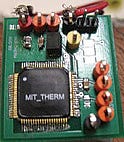April 14, 2010
|
(click to enlarge) |
In the future, a casual mention of "the patch" might not be a reference to the nicotine patch many smokers now use to try and kick their habit. Through their research on self-powered systems, a team of researchers is exploring thermal energy harvesting to advance the development of body-worn sensor patches that monitor physiological conditions.
Body-worn devices can record glucose levels or provide ECG monitoring, for example. They also exhibit a great deal of promise for future detection and monitoring applications. But the lifespan of these devices, like many products, is often limited by battery life. Harvesting thermal energy to power these sensor-equipped devices, however, could prolong battery life or even supplant the need for batteries altogether, according to Anantha Chandrakasan, an MIT (Cambridge, MA; www.mit.edu) professor of electrical engineering and director of the school's Microsystems Technology Laboratory, and Yogesh Ramadass, a former MIT PhD student.
"Our focus is to build the power-management circuits to maximize energy transfer," Chandrakasan says. Developed as a complete power-management solution for thermal energy harvesting, the researchers' energy-efficient microsystems are, in a sense, body-heat activated. Differences in temperature between the device wearer's body and the air induce heat to migrate to the cooler region of a thermoelectric system. This heat flow carries electrons with it, thereby generating a current. It is this energy that the researchers are harvesting. "When you have the thermal harvester on your body, it gives a very low electric voltage," Ramadass explains. "So, the chip that we built takes this very tiny voltage and converts it into a form that is usable by the circuits."
Exploiting thermal energy as a source of power for biomedical applications has become the subject of a great deal of research in recent years. The MIT thermoelectric systems deviate from other technologies, though, through their ability to harness minute temperature differences of only a couple of degrees. They can generate roughly 10 to 100 µW of power, according to Chandrakasan.
While thermal energy harvesting demonstrates potential for powering wearable sensors, harnessing vibration energy, on the other hand, could someday power implantable devices, notes Ramadass. "As you're walking, with whatever vibrations are created, you would just generate enough energy internally to power implantable electronics." By enhancing or eliminating batteries as power sources, this vibration sensor, Ramadass speculates, could allow engineers to design smaller devices, cut costs, and improve patient safety by eliminating the need for explantation procedures based on impending power loss. But unlike the thermal harvester, which could be ready for commercial application relatively soon, the vibration sensor requires more research, according to the scientists.
About the Author(s)
You May Also Like



